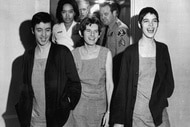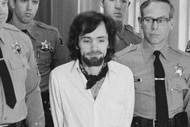Man Plays Himself In Peacock Docuseries Version Of His Life Directed By ‘Borat 2’ Filmmaker
The director of the Peacock documentary “Paul T. Goldman” found his subject “fascinating from the beginning.”

If you think you’ve seen every angle on documentary storytelling, get reel.
“Paul T. Goldman,” a six-part Peacock series premiering January 1, has found its own distinct framework as it relates the saga of a seemingly submissive man’s extraordinary walk on the wild side.
Goldman, who plays himself in the series opposite professional actors, had written about his marital breakup and fight with a supposed crime ring in his 2009 memoir, “Duplicity.”
Directed by Jason Woliner (“Borat Subsequent Moviefilm”) and executive produced by Seth Rogen, the series has been in the works for 10 years.
In a recent interview with Oxygen digital correspondent Stephanie Gomulka, Woliner said he was drawn to the project after Goldman sent him a tweet in 2012.
For Woliner, who’d been “in a phase of going down internet rabbit holes” in search of a new project, Goldman “was fascinating from the beginning,” he said. His interest grew into obsession after reading “Duplicity.”
RELATED: Exclusive: Get A Sneak Peek Of Peacock's New Docuseries 'Paul T. Goldman'
Initial plans to make a movie out of the book evolved. They morphed into the Peacock series when Woliner realized that Goldman himself was the story.
Woliner seized upon the idea of “a unique documentary,” he said. He was inspired by earlier docs he admired about offbeat individuals including Mark Borchardt from "American Movie" and Timothy Treadwell from "Grizzly Man."
Having Goldman play himself and periodically talk to the camera were devices that “emerged organically,” Woliner told Gomulka. While both narrative techniques had already occurred to the director, he decided to go in those directions only after Goldman suggested them.
“One day he just emailed me,” said Woliner. “‘Hey, what if we do it like in ‘House of Cards.’” That series occasionally broke the fourth wall.
Woliner’s experience on earlier projects led him to realize that compelling moments caught on film often occur when the cast believes that cameras have stopped rolling. The director called that material “all that extra stuff.”
As such, Woliner relied on “a code on the set” to indicate when cameras would actually roll and cut. Three cameras were used. Two of them captured scenes and a third “floating” camera became another way “to explore Paul,” he said.
The third camera picked up “fly on the wall” moments. In all, said Woliner, hundreds of hours of footage of Paul and his interactions and the crew and actors were filmed.
Capturing “all that extra stuff” led to the creative team sifting through footage like detectives painstakingly going over a crime scene.
“A lot of the editing has been the process of just combing through everything trying to find which moments are best to tell different parts of the story,” Woliner said.
“Paul T. Goldman,” a six-part Peacock series, begins streaming on January 1.


























